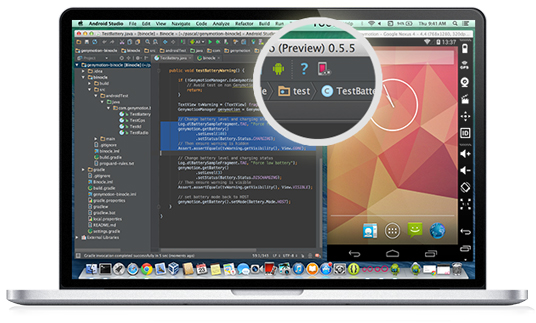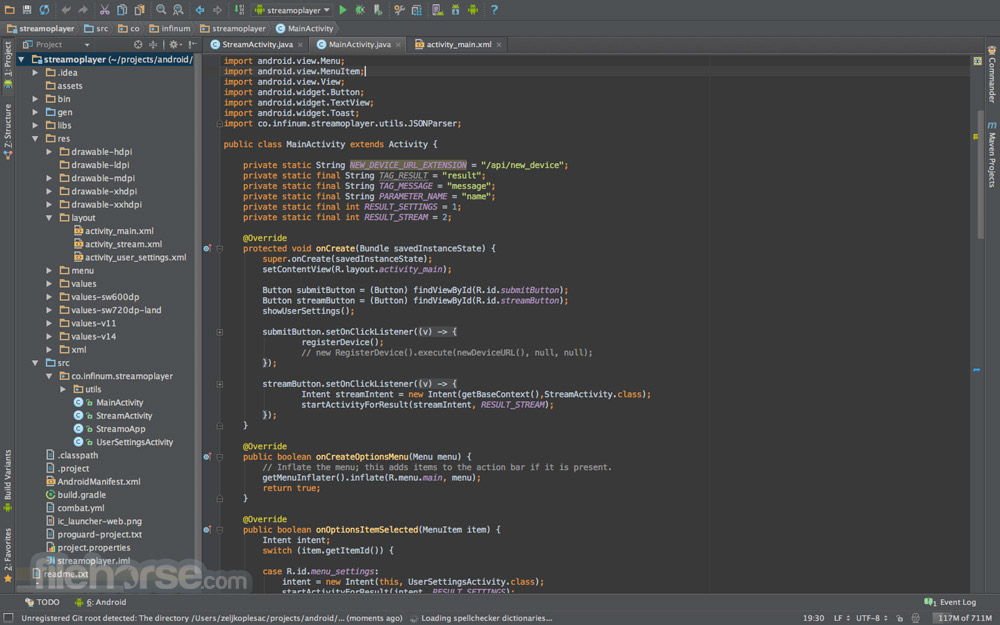Android Studio For Mac
In Android Studio on a Mac, choose Android Studio→Preferences→Appearance and Behavior→System Settings. In either case, uncheck the Reopen Last Project on Startup check box. Android Studio’s main window. Android Studio’s main window is divided into several areas. Some of these areas can appear and disappear on your command. Android Studio is a new IDE for the Android operating system. Launched by Google, it offers new tools for developing apps and is a good alternative to Eclipse, currently the most popular IDE.
Setting up Android Studio takes just a few clicks.
First, be sure you download the latest version of Android Studio.

Windows
To install Android Studio on Windows, proceed as follows:
- If you downloaded an
.exefile (recommended), double-click to launch it.If you downloaded a
.zipfile, unpack the ZIP, copy the android-studio folder into your Program Files folder, and then open the android-studio > bin folder and launchstudio64.exe(for 64-bit machines) orstudio.exe(for 32-bit machines). - Follow the setup wizard in Android Studio and install any SDK packages that it recommends.
That's it.The following video shows each step of the setup procedure when using the recommended.exe download.
As new tools and other APIs become available, Android Studio tells youwith a pop-up, or you can check for updates by clicking Help >Check for Update.
Mac
To install Android Studio on your Mac, proceed as follows:
- Launch the Android Studio DMG file.
- Drag and drop Android Studio into the Applications folder, then launch Android Studio.
- Select whether you want to import previous Android Studio settings, then click OK.
- The Android Studio Setup Wizard guides you through the rest of the setup, which includes downloading Android SDK components that are required for development.
That's it.The following video shows each step of the recommended setup procedure.
As new tools and other APIs become available, Android Studio tells youwith a pop-up, or you can check for updates by clicking Android Studio> Check for Updates.
Note: If you use Android Studio on macOS Mojave or later, you might see a prompt to allow the IDE to access your calendar, contacts, or photos. This prompt is caused by new privacy protection mechanisms for applications that access files under the home directory. So, if your project includes files and libraries in your home directory, and you see this prompt, you can select Don't Allow.
Linux
To install Android Studio on Linux, proceed as follows:
- Unpack the
.zipfile you downloaded to an appropriate location for your applications, such as within/usr/local/for your user profile, or/opt/for shared users.If you're using a 64-bit version of Linux, make sure you first install the required libraries for 64-bit machines.
- To launch Android Studio, open a terminal, navigate to the
android-studio/bin/directory, and executestudio.sh. - Select whether you want to import previous Android Studio settings or not, then click OK.
- The Android Studio Setup Wizard guides you through the rest of the setup, which includes downloading Android SDK components that are required for development.

Tip:To make Android Studio available in your list of applications, selectTools > Create Desktop Entry from the Android Studio menu bar.
Required libraries for 64-bit machines
If you are running a 64-bit version of Ubuntu, you need to install some 32-bitlibraries with the following command:
If you are running 64-bit Fedora, the command is:
That's it.The following video shows each step of the recommended setup procedure.


As new tools and other APIs become available, Android Studio tells youwith a pop-up, or you can check for updates by clicking Help >Check for Update.
Chrome OS
Follow these steps to install Android Studio on Chrome OS:
- If you haven't already done so, install Linux for Chrome OS.
- Open the Files app and locate the DEB package you downloaded in theDownloads folder under My files.
Right-click the DEB package and select Install with Linux (Beta).
- If you have installed Android Studio before, select whether you want toimport previous Android Studio settings, then click OK.
The Android Studio Setup Wizard guides you through the rest of thesetup, which includes downloading Android SDK components that arerequired for development.
After installation is complete, launch Android Studio either from theLauncher, or from the Chrome OS Linux terminal by running
studio.shinthe default installation directory:/opt/android-studio/bin/studio.sh
That's it. As new tools and other APIs become available, Android Studio tells youwith a pop-up, or you can check for updates by clicking Help >Check for Update.
Android Studio For Macos
Note: Android Studio on Chrome OS currently supports deploying your app only toa connected hardware device. To learn more, read Run apps on a hardwaredevice.Android Studio For Macbook
When you create a new project on Android Studio, the project's structure will appear with almost all the files in one SRC directory. This is a change that's been made to a generating system based on Gradle that provides greater flexibility while you're building. In addition, thanks to its integrated emulation system, Android Studio lets you view changes made to your app in real time so you can simultaneously see how everything is displayed on different Android devices according to different configurations and resolutions.
Among the many features offered by Android Studio are code-packing and tagging tools to help you organize yourself when implementing huge quantities of code, as well as a drag-and-drop system to move components around on the user interface. This new IDE also has Google Cloud Messaging, a feature to send data from the server to Android via the cloud so you can, for instance, send Push notifications to your apps. Android Studio can also help you track app development, giving you a more visual way to program and control the flow of the app.
What does Android Studio offer?
- A clear and robust development environment.
- Easy testing of functionality on different types of devices.
- Assistants and templates for commonly used programming elements on Android.
- A comprehensive editor with many extra tools to facilitate app development.
